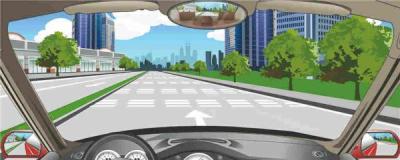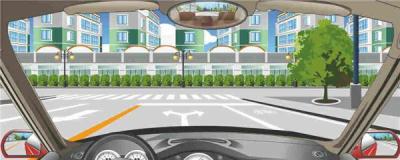1、The broken white reflective line on the road warns that drivers should drive at a lower speed on the road section ahead.

A、Right
B、Wrong
Answer:A
2、The circle in the center of the intersection indicates that drivers should drive along the inner side when making a small left turn.

A、Right
B、Wrong
Answer:A
3、The driver should take emergency evasion measures when the motor vehicle suddenly self-ignites. Which ones of the following methods are correct?
A、Spray clean water to extinguish the fire
B、Report to the police
C、Use the spare fire extinguisher in the vehicle to put out the fire
D、Set up a warning sign in the oncoming direction
Answer:BCD
4、When encountering this situation, which of the following is the correct way to overtake other vehicles?

A、Turn on high-beam
B、Use high-beam and low-beam alternatively
C、Turn on low-beam
D、Turning on hazard lamp
Answer:B
5、How should a motor vehicle follow the other vehicle In front when driving on a road covered with ice and snow?
A、Keep a long safe distance
B、Turn on hazard lamp
C、Change between high-and-low beam alternatively
D、Sound the horn in due time to give a notice to the vehicle in front
Answer:A
6、How many kinds of law-breaking acts are displayed in flash 4?

A、One
B、Two
C、Three
D、Four
Answer:C
7、Motor vehicles can turn right when driving into an intersection with this traffic signal.

A、Right
B、Wrong
Answer:A
8、This sign warns to bypass from the right side to avoid the roadblock.

A、Right
B、Wrong
Answer:B
9、vehicles to pass an intersection marked with this sign?

A、Stopping and observing the traffic situation around the intersection
B、Approaching the intersection by speeding up
C、Approaching the intersection at a reduced speed
D、Observing the traffic situation on the left rear side
Answer:A
10、The sign on the right side warns of an emergency lane 500 meters ahead.

A、Right
B、Wrong
Answer:A
11、When a motor vehicle encounters an accident on an expressway, the driver and all passengers should not get off the vehicle and walk around at will.
A、Right
B、Wrong
Answer:B
12、The guide arrow on the road surface of this lane indicates that only left and right turns are permitted on the lanes ahead.

A、Right
B、Wrong
Answer:A
13、When a tire suddenly bursts on the road, the driver should violently depress the brake pedal to reduce speed and stop the vehicle.
A、Right
B、Wrong
Answer:B
14、The solid yellow line on the curb indicates that temporary stopping or parking is allowed at the roadside.

A、Right
B、Wrong
Answer:B
15、This road marker indicates that the minimum speed for this road section is 60 km/hour.

A、Right
B、Wrong
Answer:B
16、For a temporary stop on a foggy day, the driver should only turn on the fog lamp and the low-beam
A、Right
B、Wrong
Answer:B
17、If a motor vehicle encounters a strong side wind when it leaves the opening of an expressway tunnel, what will happen?
A、A feeling of deceleration
B、A feeling of acceleration
C、A feeling of pressure
D、Deviation in direction
Answer:D
18、When overtaking on a rainy day, drivers should turn on headlamps and sound a long horn.
A、Right
B、Wrong
Answer:B
19、When driving on road sections where safe sight distance is affected, such as the top of a ramp, what should drivers do to ensure safety?
A、Rush through
B、Use hazard lamp
C、Cut speed and sound the horn
D、Drive at will
Answer:C
20、Before driving, it is necessary to check whether the cooling liquid, engine oil and fuel oil, are leaking.
A、Right
B、Wrong
Answer:A
21、Drivers may turn left when traffic police give these hand signals.

A、Right
B、Wrong
Answer:B
22、The sign on the left indicates no U-turn at the intersection ahead.

A、Right
B、Wrong
Answer:A
23、When there is a braking failure on a downhill road, if there is no other alternative, the driver may rub the vehicle body against the rocks and trees on roadside to force the vehicle to slow down and stop.
A、Right
B、Wrong
Answer:A
24、When a motor vehicle passes over an inundated road the driver should change to a low gear and pass at a constant speed.
A、Right
B、Wrong
Answer:A
25、When the wounded person is suffering main artery bleeding, where should the rescue personnel press by thumb to stop the bleeding?
A、The artery near the heart
B、The artery lower to the wound
C、The artery further from the heart
D、The artery in the center of the wound
Answer:A